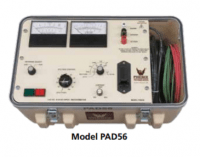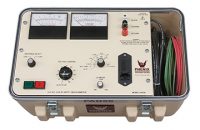Typical applications for these units are Dielectric Withstand Testing, Insulation Resistance and Leakage Current Measurement. All models measure either leakage current flow through or insulation resistance levels of the ground insulation of the test object. These testers are used for Switchgear, Cables, Motors, Generators and many other devices.
- Lightweight and ruggedly constructed for years of field use
- Units feature easy to read analog meters and user-friendly controls
- AC and DC testing capability 5 kV AC / 6 kV DC
GENERAL INFORMATION ON HIGH VOLTAGE TESTING
When we are ready to test in a High Voltage environment, general safety precautions should be taken into account as Hipot testers are capable of providing POTENTIALLY LETHAL VOLTAGES!
Improper operation or test practices may result in injury or death to the operator or surrounding personnel. The operation of High Voltage test equipment should only be performed by personnel familiar with HIGH VOLTAGE testing and safety procedures. The operator of this equipment must be aware of all hazards associated with High Voltage testing. The operator is responsible for himself and others in close proximity of the testing area.
Some General Safety Practices for working with High Voltage test equipment have been listed below for your reference.
- Become familiar with your instrument before performing an actual test.
- Know your work area, check that all circuits are de-energized and locked out.
- Never work alone; always work with another qualified worker.
- Mark off entire work area with barriers and warning tape.
- Make all personnel aware of your testing activities.
- Be aware of dangerous conditions that may arise from energizing a test specimen.
- Never modify test equipment; modifications to equipment could introduce an unknown hazard or hinder a designed-in safety feature.
- DO NOT operate damaged equipment. Remove power, and do not use the equipment until safe operation can be verified by service-trained personnel.
Terminology
The following terms relate to testing applications in the Electrical Laboratory or temporary Laboratory Set-up and in Test Stations.
High Voltage (HV)
Voltages exceeding 1000 V rms AC or 1000 V DC with current exceeding 2 mA AC or 3 mA DC.
Interlock
Safety circuit to prevent energizing HV generators until all access doors are closed, and immediately de-energizes HV if door is opened; this function does not necessarily ensure full discharge of stored energy.
Earthing System
HV test labs with earthing systems reduce potential increases and overvoltages to avoid danger to operators or control and measuring equipment.
Grounding/Discharge Stick
- Before touching HV circuit components or leaving unattended and exposed, they must be de-energized and grounded with a grounding/discharge stick.
- Grounding/discharge sticks must remain visible on HV terminal until circuit is re-energized; typically located near entrances to HV test station.
- Automated grounding/discharge systems.
Safe Clearance
The minimum distance of HV component electrodes to safety fences.
Security Circuit
PHENIX builds in a Security Circuit or auxiliary safety control device on most test sets. This consists of a removable plug that has a shorting jumper installed to complete circuit. The jumper must be removed and cable connected to user supplied device if using this provision. This feature may prevent unauthorized use until the test process has been examined by safety personnel. Optional devices may be ordered including a Gate Switch, Foot Switch, or Deadman Switch to further ensure safety.















